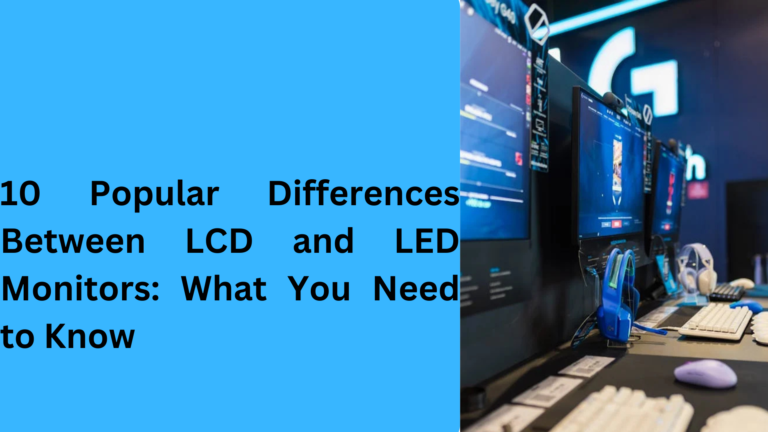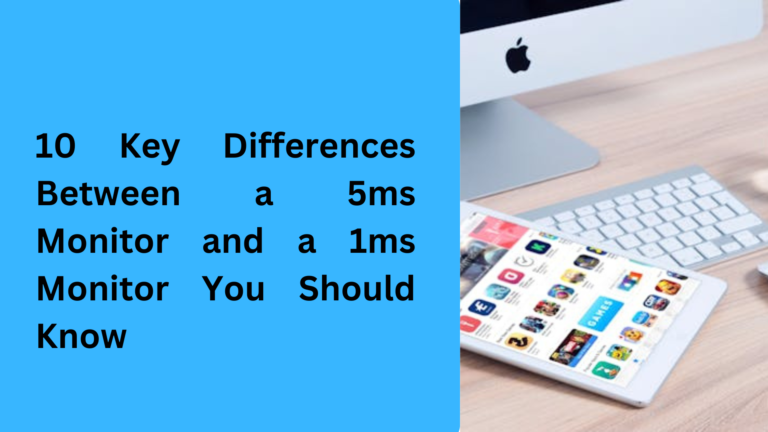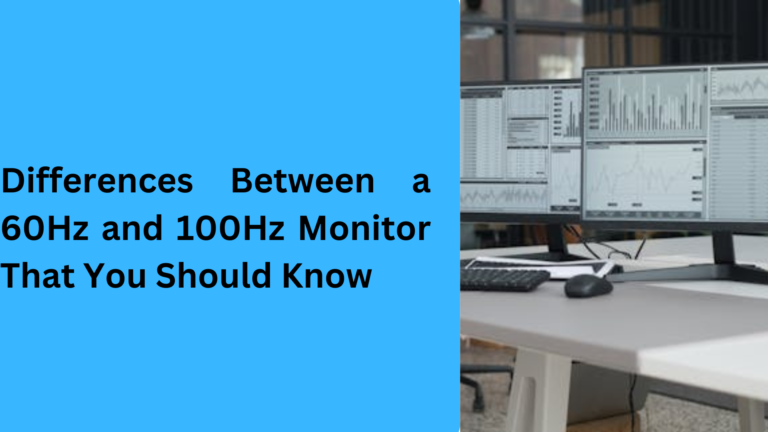10 Key Differences Between a 43 Inch Monitor and a 34 Inch Ultrawide: What You Need to Know
Choosing the right monitor can be a challenge, especially when deciding between a 43-inch monitor and a 34-inch ultrawide display. These two sizes are popular among people who want a larger screen for gaming, productivity, or multimedia purposes. Whether you’re upgrading your home office setup or building a gaming station, it’s important to understand the key differences between these monitors. In this guide, we will compare a 43-inch monitor and a 34-inch ultrawide, covering everything from screen size to display features, to help you make the best choice for your needs.
1. Screen Size and Aspect Ratio: 43 Inch Monitor vs 34 Inch Ultrawide
The first major difference you’ll notice between a 43-inch monitor and a 34-inch ultrawide is their screen size and aspect ratio. A 43-inch monitor typically has a standard 16:9 aspect ratio, which means it’s more like the typical TV or computer monitor you’re used to. A 34-inch ultrawide, on the other hand, has a 21:9 aspect ratio, which provides a wider, more immersive viewing experience.
- 43-Inch Monitor: Offers a large screen that’s perfect for multi-tasking and gaming, but it may have black bars on the sides when watching content in 16:9 format.
- 34-Inch Ultrawide: Its ultra-wide screen stretches the display horizontally, offering more space for productivity tasks, such as editing multiple documents or windows side by side.
Key Takeaway: If you prefer a traditional widescreen layout, a 43-inch monitor is ideal. However, for those who love multitasking and gaming with a panoramic view, the 34-inch ultrawide is a top choice.
2. Resolution and Picture Quality: Clarity of 43 Inch vs 34 Inch Ultrawide Monitor
When comparing resolution, both 43-inch monitors and 34-inch ultrawide displays can offer high-quality visuals, but they differ in their pixel densities. A 43-inch monitor may have 4K resolution, but it can be less sharp than a 34-inch ultrawide with a QHD resolution because of its larger screen size.
- 43-Inch Monitor: A 43-inch 4K display provides exceptional picture quality for movies, gaming, and general use. However, the large screen size means pixels might appear less sharp than a higher pixel density monitor.
- 34-Inch Ultrawide: A 34-inch ultrawide monitor often has a QHD resolution (3440×1440), which provides a higher pixel density on a smaller screen, leading to crisper and sharper images, especially when used for work and gaming.
Key Takeaway: For those who prioritize high-quality visuals with sharp details, a 34-inch ultrawide might offer better clarity. If you want the larger screen with 4K, a 43-inch monitor still delivers solid performance.
3. Workspace and Productivity: 43-Inch Monitor vs 34-Inch Ultrawide for Multitasking
One of the most important factors in choosing between a 43-inch monitor and a 34-inch ultrawide is how much workspace you need for multitasking. A 43-inch display provides ample room to have multiple windows open at once, but it might not give you the seamless workflow that a 34-inch ultrawide provides.
- 43-Inch Monitor: While you can have several windows open, the large display may make it harder to keep everything organized and visible without constantly adjusting windows.
- 34-Inch Ultrawide: The ultrawide aspect ratio is perfect for having two or three applications open side by side without overlapping. The curved models offer an even more immersive workspace, which is particularly useful for content creation, video editing, or spreadsheets.
Key Takeaway: If you need an efficient and productive workspace for multitasking, a 34-inch ultrawide monitor will offer a more organized and smooth experience compared to the larger, more traditional 43-inch monitor.
4. Gaming Experience: 43 Inch Monitor vs 34 Inch Ultrawide for Gamers
When it comes to gaming, the 43-inch monitor and the 34-inch ultrawide offer unique advantages. Gamers who enjoy a wide field of view often prefer ultrawide displays for a more immersive experience. On the other hand, 43-inch monitors are known for their massive screen size, offering a theater-like experience.
- 43-Inch Monitor: Offers a more traditional gaming setup with 16:9 aspect ratio, great for single-player games and watching movies with a cinematic feel. The large screen can give you a truly immersive experience, though not as much as the 21:9 aspect ratio.
- 34-Inch Ultrawide: Provides an immersive field of view, especially in racing, strategy, and open-world games. The 21:9 ratio adds a sense of depth and realism, offering a better overall experience in some games.
Key Takeaway: For competitive gaming, where screen space and field of view matter, the 34-inch ultrawide provides a distinct advantage. However, for a cinematic gaming experience, the 43-inch monitor is hard to beat.
5. Space and Ergonomics: How the 43-Inch and 34-Inch Monitors Fit in Your Workspace
The size of your desk or room should also play a significant role in deciding between a 43-inch monitor and a 34-inch ultrawide. A 43-inch display can take up quite a bit of space, while a 34-inch ultrawide is more compact and can fit in tighter spaces.
- 43-Inch Monitor: Ideal for those with large desks who want a big screen, but it requires more space and can dominate the room. This size might not be ideal for smaller desks or limited spaces.
- 34-Inch Ultrawide: More compact than the 43-inch monitor, the ultrawide is great for smaller spaces and setups where you need to conserve desk space. It’s a good option for people working in home offices or smaller rooms.
6. Curved vs Flat: How the Shape of the 43-Inch Monitor and 34-Inch Ultrawide Affects Viewing Experience
The curvature of a monitor can dramatically affect how comfortable and immersive your viewing experience is. While both 43-inch monitors and 34-inch ultrawide displays come in curved and flat options, the way the curve enhances the experience is different based on the size and aspect ratio.
- 43-Inch Monitor: Typically, 43-inch monitors are more commonly found in flat versions, as their large size naturally provides a wide enough viewing angle without needing a curve. This makes them suitable for users who don’t mind sitting directly in front of the screen.
- 34-Inch Ultrawide: A curved 34-inch ultrawide display enhances the immersive experience, especially if you’re sitting close. The curvature wraps the screen around your field of view, making it feel more like you’re inside the action, perfect for gaming and video editing.
Key Takeaway: If you prefer a curved screen for a more immersive experience, a 34-inch ultrawide with curvature offers a better effect than a flat 43-inch monitor.
7. Price Difference: Is the Cost of the 43-Inch Monitor Worth It Compared to a 34-Inch Ultrawide?
Price is always an important consideration when purchasing a new monitor, and there can be a noticeable difference between the cost of a 43-inch monitor and a 34-inch ultrawide display.
- 43-Inch Monitor: Typically, a 43-inch monitor is priced lower than a similarly featured 34-inch ultrawide. While some high-end 43-inch monitors, especially 4K models, can be expensive, you’ll usually find more budget-friendly options in this size range.
- 34-Inch Ultrawide: Ultrawide monitors tend to be more expensive because of the unique aspect ratio and the added benefits of extra screen real estate. Although they can offer superior productivity and gaming experiences, they come with a higher price tag.
Key Takeaway: If you’re on a budget, a 43-inch monitor can often offer better value for larger screen sizes. However, for those who prioritize the wide aspect ratio and better productivity, a 34-inch ultrawide, while pricier, offers a unique experience.
8. Connectivity Options: Comparing the Ports and Inputs of 43-Inch and 34-Inch Monitors
Another factor to consider when choosing between a 43-inch monitor and a 34-inch ultrawide is their connectivity options. Different displays come with varying types of ports, which can affect your ability to connect devices like gaming consoles, laptops, or external monitors.
- 43-Inch Monitor: Typically, 43-inch monitors come with a wide range of connectivity options like HDMI, DisplayPort, and sometimes USB-C. These monitors are great for people who want to connect multiple devices or use the display for media streaming from a variety of sources.
- 34-Inch Ultrawide: Ultrawide monitors, especially those designed for productivity, often come with more specialized ports, including USB hubs, multiple HDMI and DisplayPort connectors, and even picture-in-picture functionality. This is perfect for users who need to toggle between multiple devices without switching cables.
Key Takeaway: For multiple device connectivity and versatility, both types of monitors offer solid options, but the 34-inch ultrawide’s ports are often better designed for productivity setups.
9. Power Consumption and Energy Efficiency: 43-Inch Monitor vs 34-Inch Ultrawide
Energy efficiency is an important consideration for both environmental and cost-saving reasons, especially when you’re using a large display for long periods. The power consumption of a 43-inch monitor versus a 34-inch ultrawide can vary depending on the model and features.
- 43-Inch Monitor: A 43-inch 4K display can consume more power due to its larger size and high resolution. These monitors may require more energy to light up the screen, making them less efficient compared to smaller monitors.
- 34-Inch Ultrawide: Generally, ultrawide monitors tend to consume less power than large 43-inch models, especially when they have a lower resolution like QHD. This can save energy costs in the long run if you use the monitor for extended periods.
Key Takeaway: For those looking to save on energy bills, the 34-inch ultrawide is typically more energy-efficient than the larger 43-inch monitor, especially when used for work-related tasks.
10. Ideal Use Cases: Which Tasks Are Best for a 43-Inch Monitor vs a 34-Inch Ultrawide Monitor?
Finally, understanding the ideal use cases for a 43-inch monitor versus a 34-inch ultrawide will help you make a more informed decision. Both monitors have their strengths, but their ideal usage can vary.
- 43-Inch Monitor: This size is perfect for watching movies and TV shows, gaming, or working with large datasets. If you like to have multiple windows open side by side but don’t need the extreme width of an ultrawide, a 43-inch monitor will be a great choice.
- 34-Inch Ultrawide: The 34-inch ultrawide is the go-to monitor for professionals who need to multitask efficiently. It’s great for software development, video editing, and graphic design, where you need a wide screen for working on timelines, code, or large images.
Key Takeaway: If you want an all-around display for entertainment, a 43-inch monitor is the better choice. However, for professionals who need an efficient and ergonomic workspace, the 34-inch ultrawide excels.
Here are five FAQs with long-tail keywords integrated naturally for better SEO and clarity:
1. What is the difference between a 43-inch monitor and a 34-inch ultrawide display for gaming?
When comparing a 43-inch monitor vs a 34-inch ultrawide for gaming, the main difference lies in the aspect ratio and the field of view. The 43-inch monitor typically has a 16:9 aspect ratio, offering a more traditional widescreen gaming experience, while the 34-inch ultrawide comes with a 21:9 aspect ratio, giving a wider and more immersive gaming field of view. The ultrawide aspect ratio is especially beneficial for racing and open-world games, providing a cinematic experience. However, a 43-inch monitor can offer a larger screen size, making it ideal for users who enjoy a larger display for single-player gaming.
2. Should I buy a 43-inch 4K monitor or a 34-inch ultrawide for productivity?
If you’re looking for the best productivity monitor, a 43-inch 4K monitor offers a large screen size for multitasking with more room for open windows. However, a 34-inch ultrawide monitor is often the preferred choice for productivity because of its wider 21:9 aspect ratio, allowing for more efficient multitasking. With a 34-inch ultrawide, you can easily manage multiple applications side by side without the need for resizing, which can significantly improve workflow, especially for tasks like coding, design, and video editing.
3. How much space do I need for a 43-inch monitor vs a 34-inch ultrawide?
The amount of space needed for a 43-inch monitor vs a 34-inch ultrawide varies significantly. A 43-inch monitor requires a large desk or workspace to accommodate its size, especially if you’re looking for an immersive viewing experience. On the other hand, a 34-inch ultrawide monitor takes up less physical space while still offering a wide screen for multitasking. If you have limited desk space, the 34-inch ultrawide might be a better fit, especially when paired with a curved model for an enhanced viewing experience.
4. Which monitor offers better picture quality: 43-inch 4K or 34-inch ultrawide QHD?
The picture quality difference between a 43-inch 4K monitor and a 34-inch ultrawide QHD depends on what you prioritize. A 43-inch 4K monitor provides higher resolution (3840×2160) on a larger screen, which is ideal for watching movies or gaming in high definition. However, a 34-inch ultrawide QHD display (3440×1440) offers a better pixel density for sharper images on a smaller screen. If you’re looking for crisp visuals and sharper text for productivity tasks, the 34-inch ultrawide might offer better clarity, while the 43-inch 4K monitor is better for large-scale content viewing.
5. What are the best uses for a 43-inch monitor compared to a 34-inch ultrawide?
The best uses for a 43-inch monitor and a 34-inch ultrawide differ based on your needs. A 43-inch monitor is great for media consumption, such as watching movies or gaming with a traditional widescreen format. It’s also suitable for large spreadsheets or multi-window setups if you don’t mind managing larger real estate. A 34-inch ultrawide, on the other hand, is perfect for multitasking, video editing, graphic design, and even software development due to its wider screen and better workflow management. If you need a monitor for immersive gaming, video creation, or managing multiple tasks simultaneously, the 34-inch ultrawide is the better choice.



